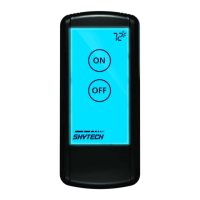INSTALLATION
The remote receiver can be either wall-mounted in a standard plastic switch box or placed on or near the fireplace hearth. Preferably,
the remote receiver should be wall-mounted in a plastic switch box, as this will protect its electronic components from both the heat
produced by the gas appliance and potential damage or abuse that can occur if it is left exposed on the hearth. PROTECTION FROM
EXTREME HEAT IS VERY IMPORTANT. Like any piece of electronic equipment, the remote receiver should be kept away from
temperatures exceeding 130
0
F inside the receiver case. Battery life is also significantly shortened if batteries are exposed to high
temperatures. Make sure the remote receiver switch is in the OFF position. It is recommended that 18 gauge solid or stranded wires
(included) be used to make connections between the terminal wiring block on the millivolt gas valve or electronic module and the wire
terminals on the remote receiver. For the best results, use 18-gauge solid or stranded wire, with no splices and measuring no longer
than 20 feet.
WALL MOUNTING
Install 4 AA-size 1.5 ALKALINE batteries in the remote receiver. For best performance, remote receiver batteries should be factory
fresh when installed. Very little battery power is required to operate the remote receiver, but the electronics are tuned to operate best
when battery output is greater than 5.3 volts. Four new AA batteries should provide an output voltage of 6.0 to 6.2 volts. Be sure
batteries are installed with the (+) and (-) ends facing the correct direction.
To attach Cover Plate to Receiver box
Position the receiver as shown in diagram to the left with
lower tab on cover plate inserted into groove of receiver
(Make sure the LEARN hole on cover plate properly
aligns with remote receiver) Pull Receiver up and snap
into top tab of cover plate.
Position the cover plate so the word ON is facing up;
then, install the remote receiver into the plastic switch
box using the two long screws provided. Push the White
Button over the receiver slide switch only after making
sure the remote receiver has LEARNED the transmitter’s
security code (see LEARNING TRANSMITTER TO
RECEIVER section.
NOTE: The remote receiver will only respond to the transmitter when the 3-position slide button on the remote receiver is in the
REMOTE position. If the system does not respond to the battery transmitter on initial use, see LEARNING TRANSMITTER TO
RECEIVER, and recheck battery positions in the remote receiver.
HEARTH MOUNT
The remote receiver can be placed on the fireplace hearth or under the fireplace, behind the
control access panel. Position where the ambient temperature inside the receiver case does
not exceed 130
0
F.
NOTE: Black Slide Button is used for Hearth Mount applications.
WIRING INSTRUCTIONS
A qualified electrician or a gas technician who is familiar with the gas appliance and gas
valves that will be operated by this remote should install the remote control system. Incorrect wiring connections WILL cause damage
to the gas valve or electronic module operating the gas appliance and may also damage the remote receiver.
WIRING MILLIVOLT VALVES
The remote receiver is connected to the millivolt valve using the TH (thermostat) terminals on the terminal block on the millivolt gas
valve. Connect 18 gauge solid or stranded wires from the remote receiver to the gas valve.
Operation of the remote receiver is similar to that of a thermostat in that both turn the gas valve on
and off based on input signals. A thermostat’s input signals are different temperatures. The
remote receiver’s input signals come from the transmitter.
Connect each of the two wires leading from the TH terminals on the millivolt gas valve to either of
the two wire terminals on the remote receiver. Normally it does not matter which wires go to which
terminal.

